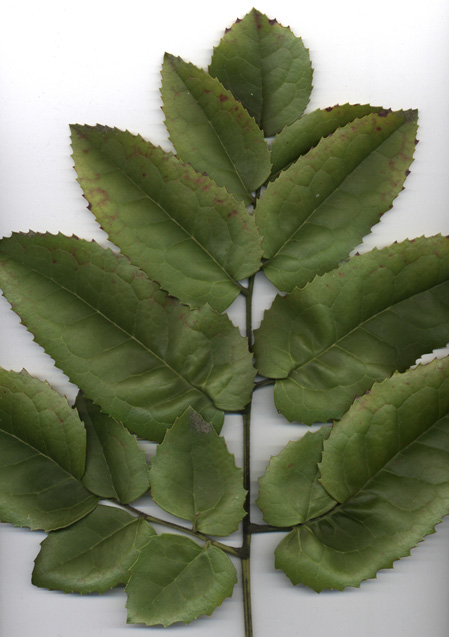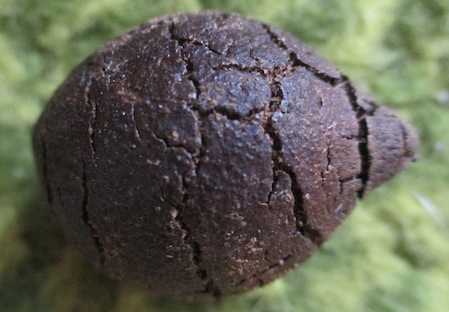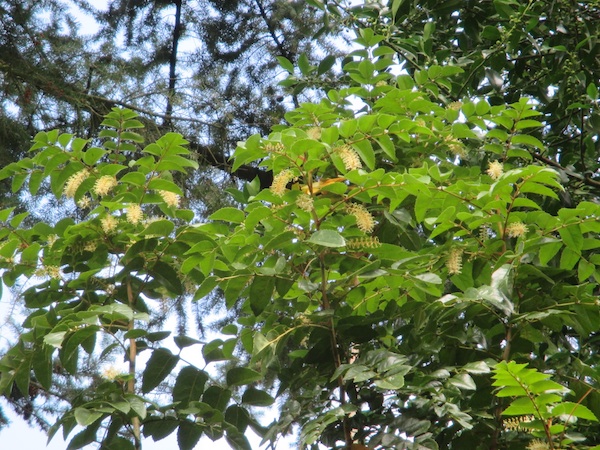| Also called Hardy Macadamia, Chile Nut, and in Spanish Avellano, this native of south Chile and Argentina, is extremely little cultivated or known in the northern hemisphere. Hence this article. I first learned about this tree in the 1980s from Michael Dolan, who owns Burnt Ridge Nursery, in Onalaska, Washington. Michael, a nut tree expert, had desired to try growing this tree, but was unable to find a local source. So he imported seeds from Chile, raised a crop, and sold the offspring. I got two, in 1986. One died; the second froze to the ground in 1990. After it resprouted it has been booming, and is now 13 or 14 feet tall (23 feet tall in 2009; 27.5 in 2012 --and blooming finally). Visitors to my garden often remark how it recalls a robust Mahonia species. |
| The Chilean hazel was named in 1782. The name Gevuina (spelled in some old sources Guevina) is an approximation of the common name in Mapuche: Guevin. The name Avellana was selected to compare it to Corylus Avellana, the European hazelnut. Gevuina is a genus of only this one species. It is a broadleaf evergreen that varies from a shrub to a tree 60 feet tall. It grows from sea level to nearly 2,300 feet (700 meters) in elevation. Its range extends from 35 to 44 degrees south latitude. |
| By 1826 it was introduced to cultivation in the British Isles. I do not know when it was first tried in North America, certainly by the early 1900s if not before; but it has always been extremely rare here. The oldest that I am aware dates from 1963, and I saw it in 1995 in the Berkeley Botanic Garden, when it was still bushy. I have a hunch that the heat of California annoys the plant; the cold freezes of interior North America kill it; and the indifference of most gardeners elsewhere leave it untested. Yet in the coastal portions of the Pacific Northwest it ought to thrive, as it does in Ireland, Scotland and milder parts of England, not to mention in New Zealand. The tallest recorded in the British Isles was 55 feet (17 meters) in 1986, and the stoutest trunk more than 1 foot thick. Specimens I have seen in California, and even in Seattle, are primarily of shrubby appearance. Mine alone is emphatically treelike, bolt upright, and one can walk under its crown. |
| The foliage is bold, and the leaves highly variable. Each leaf is compound, either simply pinnate with only 5 to 11 leaflets, or doubly pinnate, with as many as 95 leaflets. The overall compound leaf can easily measure more than 2 feet in length, and the largest individual leaflet I measured was 9 inches long and half that wide. The illustration below shows only a part of a compound leaf. I cannot think of any tree leaf that is thicker. The gloss is low to medium, and the color is a bit bronzy-green rather than bright pure green. But the young growth as it unfurls is strikingly handsome velvety maroon, like the fuzz of staghorn sumach (Rhus typhina). |
| Anywhere between July and November it can bloom. The flowers are individually small, but borne in abundant narrow clusters up to 6 inches long. They tend to be creamy-white but can be greenish or touched with pink. They are not especially showy. They give rise to dark red fruits that resemble a sort of cherry. It is the roasted seed or nut that people eat. |
| Even an isolated tree can set fertile nuts. The nuts are easily shelled. An analysis showed the nuts contain 12.5 percent protein, 49.5 percent oil, and 24.1 percent carbohydrate. The highly monosaturated oil is also extracted for varied uses in in Chile. It is a good source of natural antioxidants. |
| Other uses in Chile include the cut foliage for use in floristry; the flowers are good bee attractants; the wood is valued. |
| Pacific Northwest nurseries that have offered Chilean Hazels via mail order include Burnt Ridge (not since the 1980s), Cistus, Colvos Creek, Forest Farm, and Heronswood (1999-2002). At any one time, maybe none of these nurseries will have any. But if enough requests flow in, the owners will perhaps be kept stimulated to try to meet the demand. |
| The Washington Park Arboretum in Seattle has a specimen that dates from 1989. It is right next to the road across from the New Zealand High Country exhibit. It is a giant shrub, about 11 or 12 feet tall. It makes nuts every year. One nurseryman told me that as he germinated seeds from it, rodents ate every one. |
To me the nuts are not a great treat, but I think it fun to grow a tree related to the cold-tender Macadamia. The tree is adaptable to highly varied soils and sun levels. If you obtain one yourself, or raise one from a nut, be aware that at least while young this species is hurt if you fertilize it with phosphorus. Also the tree is very susceptible to Phytophthora cinnamomi root rot.
|
For more information see a detailed article in the journal Economic Botany April-June 1996, pages 224-235. The article stresses the possibility of New Zealand cultivation of this tree.
Back
|

Chilean Hazel leaf; scan by ALJ
|

Chilean Hazel Gevuina nut an inch long; photo by ALJ
|

Chilean Hazel flowers; photo by ALJ
|

